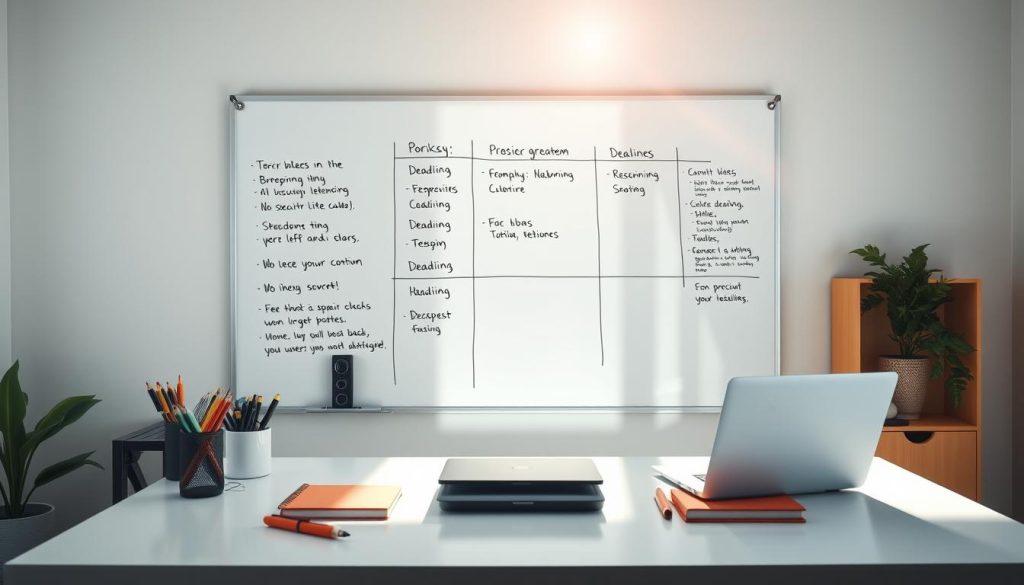Finding a sustainable way to combine career goals with family and personal time matters more now than ever. The rise of freelancing in France and across Europe gives many people control over hours and clients, but it also brings real health risks if work spills into every corner of life.
Data shows 69% of independent professionals report better overall balance than in full-time jobs, yet burnout can harm sleep, focus, productivity, and cardiovascular health (Dr. Suzanne Degges-White).
This short guide offers practical tips and a friendly roadmap to protect family time without hurting client relationships. You’ll learn how to set office hours, build a realistic schedule, and create a dedicated workspace that helps separate work and personal life.
We’ll also preview tools and routines—calendars, project boards, intentional breaks, and a shutdown ritual—that make time management less stressful. For more on setting practical routines, see this practical guide on organizing your day for independent workers.
Think of balance as a skill to practice: it changes with your career stage, clients, and family needs. The sections ahead cover boundaries and office hours, daily time blocking, task priority systems, client selection, smart tech habits, community support, and quick wins to try today.
Table of Contents
Key Takeaways
- Clear boundaries and set hours protect personal time and reduce burnout.
- A dedicated workspace and shutdown ritual help separate work and life.
- Digital tools—calendars and project boards—improve time management.
- Discipline and realistic scheduling sustain long-term health and career growth.
- Balance looks different for everyone; adjust routines as life and clients change.
Why freelance work-life balance advice matters right now
The rise in independent gigs means managing time and stress is now a business skill, not an optional comfort.
Sixty-nine percent of independent professionals report better balance than in their old job, yet burnout remains common: 77% of American workers show symptoms. This gap shows that feeling freer does not erase health risks.
Discipline matters. Sixty percent of freelancers say routine and set office hours improve outcomes. Respecting those hours helps protect family moments and keeps client service consistent.
Structured workflows lower stress and boost productivity during busy times of the month or quarter. Small steps—clean schedules, realistic capacity planning, and clear availability—compound into real gains.
Social ties reduce isolation. Communities like Field Engineer, with 75,000+ members across 200+ countries, offer support, gigs, and practical tips. Seeking that support is a smart move, not a luxury.
- Prevention beats recovery: prioritize schedule hygiene and niche-specific adjustments.
- Balance is foundational: it sustains productivity, client trust, and long-term career health.
Set clear boundaries between work and personal life
When you mark the start and end of work, your days and energy become more predictable. A simple structure protects family routines and keeps clients satisfied. Below are practical steps to create a clear line at home and guard your time.
Create a dedicated home workspace
Sixty percent of professionals say a designated workspace helps separate work from relaxation. A small desk in a quiet corner signals « on duty » to your brain and family.
Establish office hours and communicate them
Pick work hours that fit your household and make sure clients and loved ones know when you are available. Use short messages to set expectations and preserve weekends.
Adopt a daily shutdown ritual
Try Cal Newport’s approach: review tasks, update your board, set the next day’s top three, then say a phrase that marks the end. Micro-habits like closing your laptop or a five-minute walk help signal the end of the day.
| Action | Why it helps | Quick script |
|---|---|---|
| Dedicated desk | Faster context switch; protects family time | « I work here from 9–13; please knock only for emergencies. » |
| Set office hours | Reduces late requests; steadier schedule | « I reply to clients between 10–16 on weekdays. » |
| Shutdown ritual | Ends rumination; improves recovery | « I’m done for today — see you tomorrow at 9. » |
Try a short experiment: test stricter work hours for a few days and note changes in focus and energy. For more on keeping work and life distinct, see this guide: work-life balance tips.
Design a sustainable daily schedule that actually fits your freelance career
A realistic daily schedule protects your focus and keeps important projects moving forward.
Use time blocking to reserve prime hours for deep work. Put your highest-impact project in the slot when your energy peaks. Save lighter tasks—emails, quick edits, admin—for lower-energy times.
Use time blocking to protect deep work on key projects
Time blocking reduces context switching and helps you complete complex project phases faster. Batch similar tasks—research, writing, calls—to keep momentum and cut friction.
Schedule short breaks to reduce stress and prevent burnout
Try Pomodoro-style cadences like 25/5 or 50/10. Short, regular breaks reduce fatigue and lower stress while keeping productivity steady.
Build evening routines to wind down and improve sleep
End your day with a shutdown ritual: log off, quick stretch, and a short analog read. Studies show wind-down routines improve sleep and readiness the next morning.
Protect admin time. Block one session for invoicing, proposals, and email so these tasks do not invade deep-work hours. Automate calendars and templates where possible; 63% of people see productivity gains from small automations.
| Action | When | Benefit |
|---|---|---|
| Prime deep-work block | Peak energy slot (e.g., 9–11) | Faster completion of high-impact projects |
| Admin batch | Afternoon or end of day | Keeps interruptions out of creative hours |
| Short breaks | 25/5 or 50/10 cadence | Reduced stress; sustained momentum |
| Evening routine | 30–60 minutes before night | Better sleep and next-day focus |
Track one week to compare planned hours against reality. Tweak the schedule to match your natural rhythm and the demands of your career. Small, repeatable routines create space for rest and steady output.
For more practical tips on balancing hours and life as an independent worker, see this short guide: tips for balancing work and life as a.
Prioritize with purpose and learn to say no
A purposeful approach to tasks frees time for high-impact projects and family moments. Clear priorities protect your hours and reduce reactive stress. Use simple methods to keep your day focused and preserve energy for what matters.

Apply the Eisenhower Matrix to sort urgent versus important tasks
The Eisenhower Matrix helps you separate urgent noise from strategic work. Data shows 65% of freelancers reported better productivity after using this method.
Place each task into one of four quadrants: do now, schedule, delegate, or delete. This keeps revenue-driving projects in prime slots and pushes trivial items out of your day.
Keep a realistic to-do list to focus your day
Keep one short list each morning with three top tasks. Batch similar tasks to save transition time and protect deep work.
Prune non-essential items weekly. Removing low-value jobs reduces overwhelm and cuts risk of burnout.
Recognize limits, choose the right clients, and turn down misaligned jobs
Use clear criteria: scope clarity, polite communication, and realistic timelines. These filters help you accept clients who respect boundaries and rates.
« Thanks for the offer — my schedule is full this month. If timelines shift, I’d be happy to revisit. »
Purposeful no’s are strategic yeses to better projects and a sustainable career. Revisit priorities monthly to match seasonal demand and personal goals.
Leverage technology without letting it run your life
Treat tech as a tool, not a tyrant: choose systems that free time and protect family hours. The right stack keeps projects on track and stops apps from stretching your day.
Pick a simple stack: one calendar plus a project tool like Trello or Asana. These platforms centralize tasks and deadlines so nothing slips through the cracks.
- Set reminders, due dates, and recurring checklists to reduce cognitive load and keep client delivery steady.
- Build buffers into timelines so surprises don’t erode your hours or family time.
- Automate templates and booking links to save repeat work without sounding impersonal.
Use wellbeing apps to decompress, but pair them with daily no-screen windows. Many users report better health with mindful tech use, and separate devices or profiles prevent bleed-over between client tasks and personal life.
Do a weekly review inside your tool: align projects, capacity, and schedule. Remove noisy apps that create stress so technology serves your system—not the other way around.
Stay connected and take care of your health
Staying connected and tending to your health keeps energy steady and makes the long hours more manageable. Social ties and movement are practical levers that guard focus and reduce stress on busy days.

Join communities for support and opportunities
Online and local groups help you trade leads, solve client issues, and feel less alone. Field Engineer hosts 75,000+ freelancers across 200+ countries, showing how large communities can be a real source of support.
Schedule catch-ups to protect family and life outside work
Block recurring calls or dinners with friends and family so personal time is not optional. These default slots make it easier to say no to late requests and keep your days predictable.
Prioritize movement and mental health for better productivity
Short walks, yoga, or gym sessions sharpen focus and creativity. Wellness apps help 78% of users feel healthier, and regular activity reduces loneliness common in solo jobs.
- Create an accountability partner in your community to share goals and resources.
- Use group norms to push back on unrealistic client demands.
- Do a weekly self-check on mood, energy, and social contact to catch early signs of burnout.
« Community and small health habits are not extras — they protect your work and life. »
Freelance work-life balance advice you can act on today
Act on clear, small steps you can finish this week. Set and share office hours with key clients. Block two weeks in your calendar for deep work, admin, and family anchors so your days feel predictable.
Write a short daily list: three must-do tasks and one small win. This keeps productivity steady and reduces churn from endless decisions.
Adopt a quick shutdown ritual tonight: review tasks, set tomorrow’s top three, close apps, and say a short phrase to mark the end. Try a wellness app and a 20–30 minute walk midday — studies show apps help health for many users.
- Pick one calendar and one project tool; set recurring reminders for invoicing and follow-ups.
- Create a simple autoresponder with your hours and response expectations.
- Join one relevant community and post a short intro to expand support.
- Set a daily no-screen window—during dinner or a walk—to protect personal life and rest.
Quick wins add up: automation raises productivity by around 63% and wellness tools report strong health benefits. For more practical work-life balance tips, see work-life balance tips.
Conclusion
Small, repeatable routines protect your evenings and keep client work reliable. Defined hours, clear boundaries, smart tech, community support, and self-care cut stress and lower burnout risk.
Remember: 69% report better balance than full-time roles, but proactive maintenance keeps that advantage over the long term.
Core playbook: set realistic hours, prioritize with purpose, keep steady routines, and revisit priorities monthly to prevent slow creep toward overload.
Pick one change today (a shutdown ritual or set office hours) and one this week (join a supportive group). Sustainable freelancing is a marathon, not a sprint—protect nights, weekends, and family time to keep creativity and health strong.
FAQ
How do I set firm work hours when clients expect instant replies?
Start by choosing a regular block of hours that fits your peak focus time. Share those office hours in your email signature, client contracts, and on platforms like Upwork or LinkedIn. Use an autoresponder outside those hours to set expectations and offer the next available response time. If a client needs urgent help, offer an emergency rate — that protects your schedule and discourages casual after-hours requests.
What’s the simplest way to stop working at the end of the day?
Create a short shutdown ritual: review completed tasks, note three priorities for tomorrow, close work tabs, and physically leave your workspace. A five-minute ritual signals your brain that the day is over and helps you separate work from personal life. Consistency makes this habit stick.
How can I avoid burnout when juggling multiple projects and tight deadlines?
Time block your calendar to reserve deep-focus sessions for high-value projects, and schedule short breaks every 60–90 minutes. Limit consecutive client calls, delegate or outsource lower-value tasks, and keep one day a week with lighter or no deadlines when possible. Regular exercise and sleep also reduce stress and keep productivity steady.
What tools help manage projects and deadlines without constant notifications?
Use a calendar app (Google Calendar), a project manager (Trello, Asana, or Notion), and a time tracker (Toggl) for visibility. Turn off nonessential notifications and set a single daily check-in for messages. These tools centralize tasks and lower context switching so you control when you respond.
How do I choose clients that fit my goals and limits?
Assess potential clients by their payment terms, communication style, and project scope. Ask specific questions during the intake: deadlines, approval rounds, and preferred contact times. If red flags appear (vague briefs, slow pay, scope creep), be ready to decline. Saying no preserves your time for projects that match your rates and lifestyle.
What’s a practical way to use the Eisenhower Matrix for daily planning?
At the start of the day, list your tasks and sort them into four buckets: urgent+important (do now), important+not urgent (block time for later), urgent+not important (delegate), and neither (remove). Focus on one or two important tasks during your best hours to make meaningful progress.
How can I protect personal time while working from home with family around?
Set a dedicated workspace and post visible office hours for family. Use a simple visual cue — a closed door or a sign — to show when you’re unavailable. Schedule regular family time in your calendar so personal life is treated with the same priority as client work.
Are short breaks really effective for productivity, and how often should I take them?
Yes. Short breaks every 60–90 minutes reset attention and reduce decision fatigue. Try the Pomodoro-influenced rhythm: 25–50 minutes of focused work, then 5–10 minutes off. Use breaks to stretch, hydrate, and step away from screens to sustain focus over long days.
How do I balance using productivity apps without becoming screen-dependent?
Limit app use to essential planning and tracking. Combine digital tools with analog habits: a paper to-do list, a physical timer, or a whiteboard. Schedule tech-free windows each day to restore attention and prevent overreliance on devices.
What practical steps can I take today to improve my schedule and reduce stress?
Pick one change: set clear office hours, time block tomorrow’s top two tasks, or schedule a daily shutdown ritual. Start small and measure progress for a week. Small wins build momentum and make larger shifts — like healthier routines and better client selection — easier to implement.





